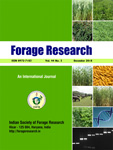R. S. DHILLON*, MURARI LAL, KARISHMA NANDA, SATPAL, MAMTA PHOGAT, MEENU AND GULAB SINGH
Krishi Vigayan Kender, Bhiwani, Department of G & PB (Forage Section)
CCS Haryana Agricultural University, Hisar-125 004 (Haryana), India
*(e-mail: rsdhillon67@gmail.com)
(Received: 4 March 2025; Accepted: 1 April 2025)
SUMMARY
n Indian agriculture, livestock plays an essential role in the development and progress of mankind with crop production program as a complementary enterprise. However, livestock productivity is constrained by an acute shortage of feed and fodder. Estimate on demand-supply gap in fodder availability shows a net deficiency of 11.23% green fodder, 23.40% dry fodder and 28.90% concentrate feed materials in the country. By 2050, the demand for green and dry feed will be 1012 and 631 million tones, respectively. In the year 2050, with the current rate of expansion in forage supplies, there will be an 18.4% deficit in green fodder and a 13.2% shortfall in dry fodder. Agroforestry is latest advertise opportunity and sustainable climate-smart cultivation, land stewardship and environment for animals. Silvipastoral agroforestry practices are low-input intervention for the waste/ unutilized lands, to check the further degradation and supply the livestock fodder through tree leaves and forages besides fuel wood, small timber and pasture seeds. The potential of agroforestry seems to be substantial; but it remains under recognized as a greenhouse gas mitigation option for agriculture in the world.
Key words: Agroforestry, fodder, sustainable, climate change, mitigation

